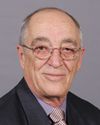It's an extremely good point, because you're quite right. Not everybody at the time of release is necessarily aware, or perhaps they are aware and they just simply don't wish to deal with it at that time. Both of those situations happen.
We intentionally, as part of the design of the new Veterans Charter, designed a new gateway that veterans could come through other than the entitlement gateway. This is the rehabilitation need entry point that Mr. Ferguson refers to. What we've been seeing in the nine months that the new programs have been in place is, in fact, that approvals for the rehabilitation program are at 94%. Most of the people who are asking for supportive benefits under that program are in fact being approved.
There's another extremely interesting point. I was just looking for the number, but I couldn't find it quickly; however, the number that sticks in my mind is 78% or around that level. Some 78% of those coming to us through that gateway today are veterans who were previously released. They're not releasing today. I think that makes the point very clearly that for folks such as the ones you're concerned about, the door remains open. There is an avenue for them to—



